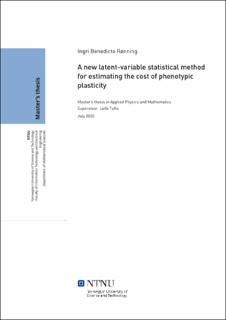| dc.contributor.advisor | Tufto, Jarle | |
| dc.contributor.author | Rønning, Ingri Benedicte | |
| dc.date.accessioned | 2021-09-15T17:27:15Z | |
| dc.date.available | 2021-09-15T17:27:15Z | |
| dc.date.issued | 2020 | |
| dc.identifier | no.ntnu:inspera:55607230:52091430 | |
| dc.identifier.uri | https://hdl.handle.net/11250/2778358 | |
| dc.description.abstract | En ny latent variabel-metode for å oppdage kostnaden av plastisitet i en population har blitt testet ved hjelp av simuleringer.
Individuell fitness ble modellert av en Poisson-fordeling med forventningsverdi i henhold til de selektive mekanismene i den gjeldende populasjonen.
De simulerte populasjonene var under fenotypisk stabiliserende seleksjon og en kostnad av plastisitet.
De individuelle avlsverdiene og plastisitetsverdiene var latente variabler i modellen.
Modellen måtte derfor inferere dem ved å anvende den infinitesimale modellen på stamtavlen over familiestrukturene til den gjeldende populasjonen.
Målet var å finne forholdene der modellen oppnår høyest statistisk styrke for å oppdage kostnaden av plastisitet i populasjonen.
Dette ble gjort ved å variere familiestrukturen i populasjonene, modellen for miljøpåvirkningen til fenotypen, og varians av plastisitet.
Resultater ble til ved å bruke Maximum likelihood estimation på den marginale rimelighetsunkfjonen med R sotftware og den åpne R-pakken TMB, og ved å benytte den asymptotiske normalfordelingen til ML-estimatorene i en analyse av statistisk teststyrke.
Resultatene avslørte at, avhenig av antagelsene på effekten av kostanden av plastisitet, finnes det en optimal familiestruktur som maksimerer den asymptotiske styrken til hver modell.
To ulike modeller for miljøpåvirkningen på fenotypen ble anvendt på de simulerte populasjonene.
Miljømodellen som deler hver familie i populasjonen inn i to distinkte grupper var det overlegne valget i modellene som antok at kostnaden av plastisitet både hadde en lineær og kvadratisk effekt.
Den andre miljømodellen samplet miljøbidragene uavhengig fra en standard normalfordeling.
I de statistiske seleksjonsmodellene som antok enten en utelukkende lineær eller utelukkende kvadratisk effekt av kostnaden av plastisitet, fungerte begge miljømodellene like bra.
Resultatene bekreftet også at kostnaden av plastisitet er lettere å oppdage i en populasjon med høyere varians i plastisitet. | |
| dc.description.abstract | A new latent-variable statistical method for detecting the cost of plasticity in a population has been tested using simulations.
Individual fitness was modeled by a Poisson distribution with expectation according to the selective mechanisms in the relevant population.
The simulated populations were under a phenotypic stabilizing selection and a cost of plasticity.
The individual breeding values and plasticity values were latent variables in the model.
Thus, the model inferred them by applying the result of the infinitesimal model to the pedigree chart of the current population.
The objective was to find the conditions under which the model attains its highest statistical power for detecting the cost of plasticity in the population.
This was done by varying the family structure of the populations, the model for the environmental contribution to the phenotype, and the level of plasticity variance.
Results were obtained using maximum likelihood estimation on the marginal likelihood function in R software with the open R-package TMB, and using the asymptotic normality of the ML estimators in a power analysis.
The results revealed that, depending on the exact assumptions on the effect of the cost of plasticity, there is an optimal family structure which maximizes the asymptotic power of each model.
Two different models for the environmental contribution to the phenotype were applied to the simulated populations.
The environmental model which split each family of the population into two distinct groups was the superior choice in the models which assumed that the cost of plasticity had both a linear and quadratic effect.
The other environmental model drew environmental contributions independently from a standard normal distribution.
In the statistical selection models which considered either an exclusive linear or an exclusive quadratic effect of the cost of plasticity, the environmental models performed equally well.
The results also confirmed that, in a population where the plasticity variance is at a higher level, the potential cost of plasticity is more detectable. | |
| dc.language | | |
| dc.publisher | NTNU | |
| dc.title | A new latent-variable statistical method for estimating the cost of phenotypic plasticity | |
| dc.type | Master thesis | |
